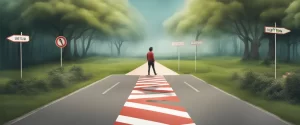
Throughout the ages, literature has served as a powerful tool for self-reflection, personal growth, and self-help. It has guided individuals towards a deeper understanding of themselves, their relationships, and the world around them. In the expansive realm of self-help literature, two remarkable works have resonated with readers and offered profound insights on the path to self-awareness and healing: “Living in the Light” by Shakti Gawain and “Codependent No More” by Melody Beattie. These two books, while distinct in their approaches, offer valuable guidance for those seeking to break free from negative patterns and embark on a journey of self-discovery. As we explore these works side by side, we will delve into their unique perspectives on self-empowerment, relationship dynamics, and the attainment of personal freedom. By contrasting and comparing the wisdom shared within these pages, we aim to unravel the common threads that unite them and shed light on the transformative potential they hold for the readers who embark on their respective journeys.
Brief Summary of Two Books
Living in the Light by Shakti Gawain
Living in the Light, written by Shakti Gawain, is a transformative guide to personal growth and self-awareness. In this book, Gawain explores the concept of “living in the light” as a means to embrace our true selves and find inner peace and happiness.
Gawain begins by explaining that living in the light involves connecting with our intuition, the wise and guiding voice within us. She emphasizes the importance of trusting our intuition and using it as a compass to navigate life’s challenges. Gawain offers practical exercises and techniques to develop and enhance intuition, such as visualization, affirmations, and meditation.
The book also delves into the transformative power of creative visualization. Gawain explains that by creating mental images of what we desire and focusing on them with intent and belief, we can manifest our desires into reality. She provides step-by-step guidance on how to visualize effectively and manifest positive changes in various areas of life, including relationships, career, health, and finances.
Additionally, Gawain explores the concept of healing through self-acceptance and self-love. She encourages readers to embrace their imperfections, release self-criticism, and cultivate a loving relationship with themselves. By cultivating self-acceptance, Gawain believes we can heal emotional wounds, overcome fears, and live authentically.
Throughout the book, Gawain shares inspiring anecdotes and personal stories, creating a relatable and engaging narrative that captivates readers. Her writing style is clear, practical, and filled with wisdom, making Living in the Light a compelling guide for anyone seeking personal growth and spiritual transformation.
In summary, Living in the Light by Shakti Gawain is a powerful and practical guide that teaches readers how to tap into their intuition, use creative visualization to manifest their desires, and cultivate self-love and acceptance. It offers valuable insights and techniques to help readers live a more fulfilling and authentic life.
Codependent No More by Melody Beattie
“Codependent No More” by Melody Beattie is a self-help book that explores the concept of codependency and provides practical advice on how to break free from its destructive patterns. The book begins by defining codependency as an unhealthy reliance on others for a sense of self-worth and identity. Beattie draws on her personal experiences as well as real-life examples to illustrate how codependency can manifest in various aspects of life, including relationships, work, and personal boundaries.
Throughout the book, Beattie emphasizes the importance of self-care and self-love as essential tools for healing codependency. She offers practical strategies, such as setting boundaries, practicing self-compassion, and detaching from unhealthy relationships, to empower readers to regain control of their lives. Beattie provides useful techniques like meditation, journaling, and affirmations to help readers develop a healthier sense of self and cultivate a stronger sense of autonomy.
“Codependent No More” also explores the concept of addiction and its connection to codependency. Beattie not only addresses substance abuse but also any behavior or thought pattern that perpetuates codependency. Through stories of recovery and personal growth, she encourages readers to seek support and take steps towards their own healing journey.
Overall, “Codependent No More” is a compassionate and practical guide for those who struggle with codependency, offering a pathway towards self-discovery, empowerment, and healthier relationships.
Comparison between Two Books

Similarities in Self-help
Living in the Light by Shakti Gawain and Codependent No More by Melody Beattie are both self-help books that aim to guide readers towards personal growth and self-improvement. While they may focus on different aspects of personal development, there are several similarities between these two books:
1. Self-awareness: Both books emphasize the importance of self-awareness as the first step towards personal transformation. Gawain and Beattie encourage readers to examine their thoughts, behaviors, and emotions. By becoming aware of oneself, individuals can identify patterns or issues that hold them back and work on changing them.
2. Empowerment: Both Gawain and Beattie believe in empowering individuals to take control of their own lives. They encourage readers to let go of victim mentality and take responsibility for their actions and decisions. By doing so, individuals can reclaim their power and create positive changes in their lives.
3. Mind-body connection: Both authors acknowledge the connection between the mind and body. They stress the importance of caring for one’s physical and emotional well-being. Gawain and Beattie suggest practices such as meditation, affirmations, and self-care activities to foster a healthy mind-body connection and overall well-being.
4. Letting go of the past: Another similarity between these books is the emphasis on letting go of the past. Gawain and Beattie recognize that holding onto past traumas, resentments, or negative experiences can hinder personal growth. They provide guidance on forgiveness, acceptance, and releasing emotional baggage as essential steps towards healing and moving forward.
5. Inner guidance: Both authors advocate for connecting with one’s inner guidance system or intuition. Gawain and Beattie emphasize the importance of listening to one’s inner voice, trusting one’s instincts, and making decisions aligned with their authentic self. By tapping into this inner wisdom, individuals can find clarity, direction, and make life choices that are aligned with their true desires.
Overall, Living in the Light and Codependent No More share common themes of self-awareness, empowerment, mind-body connection, releasing the past, and honoring one’s inner guidance. Both books provide practical tools, exercises, and personal anecdotes to support readers on their journey towards self-improvement and living a more fulfilling life.
Divergences in Self-help
Living in the Light by Shakti Gawain and Codependent No More by Melody Beattie are both highly regarded self-help books that share common themes such as personal growth and self-awareness. However, they diverge in their approaches to self-help and the specific topics they focus on.
One significant divergence between these books is their approach to spirituality and individuality. Living in the Light places a strong emphasis on spirituality, encouraging readers to connect with their inner selves and tap into their intuition. Gawain emphasizes the importance of aligning with the greater universal energy and finding personal truth and fulfillment through spiritual practices such as meditation and visualization. On the other hand, Codependent No More takes a more pragmatic and earthly approach to self-help, focusing on breaking free from codependent behaviors and establishing healthier relationships with others and oneself. Beattie addresses codependency as a way of losing one’s individuality, urging readers to prioritize their own needs and find their identity outside of others. While both books address personal growth, they differ in the emphasis they place on spirituality and individuality.
Another significant divergence is the specific topics covered in each book. Living in the Light covers a broad range of self-help topics, including visualization techniques, affirmations, and creative expression, all geared toward personal empowerment and finding one’s purpose. Gawain offers guidance on manifestation and creating a fulfilling life based on one’s desires. This book encourages readers to embrace their creativity and harness their imagination to shape their reality. On the other hand, Codependent No More focuses specifically on codependency and its impact on relationships. It delves deeply into the patterns and dynamics of codependency, providing practical steps and tools to break free from such patterns and establish healthier boundaries. Beattie addresses topics such as self-esteem, self-care, and detaching from unhealthy relationships. Unlike Living in the Light, Codependent No More has a narrower focus on codependency and its resolution.
In summary, while both Living in the Light and Codependent No More are self-help books that promote personal growth, they diverge in their approaches and topics covered. Living in the Light emphasizes spirituality, personal empowerment, and finding one’s purpose, while Codependent No More focuses specifically on codependency and establishing healthier relationships. Understanding these divergences can help readers choose the book that aligns better with their specific self-help needs.

Conclusion
Both “Living in the Light” by Shakti Gawain and “Codependent No More” by Melody Beattie are highly regarded self-help books and have made significant impacts in their respective fields. Ultimately, determining which book is more worthy of reading depends on each individual’s specific needs and interests.
“Living in the Light” by Shakti Gawain focuses on personal growth and spiritual development. It emphasizes the importance of embracing one’s inner power and living authentically. This book encourages readers to explore their creativity, intuition, and consciousness to live a more fulfilling life. It is a great choice for individuals seeking personal transformation and a deeper connection with their spirituality.
On the other hand, “Codependent No More” by Melody Beattie tackles codependency and offers guidance for breaking free from unhealthy relationship patterns. It provides practical advice, personal stories, and exercises to help readers establish healthy boundaries, focus on self-care, and build healthier relationships. This book is highly recommended for individuals struggling with codependency or those seeking insights into forming healthier connections with others.
Therefore, depending on whether you are more interested in personal growth and spirituality (“Living in the Light”) or overcoming codependency and fostering healthier relationships (“Codependent No More”), one book may be more relevant to your current needs. Both books have their own merits and can be valuable additions to anyone’s self-help reading list.



